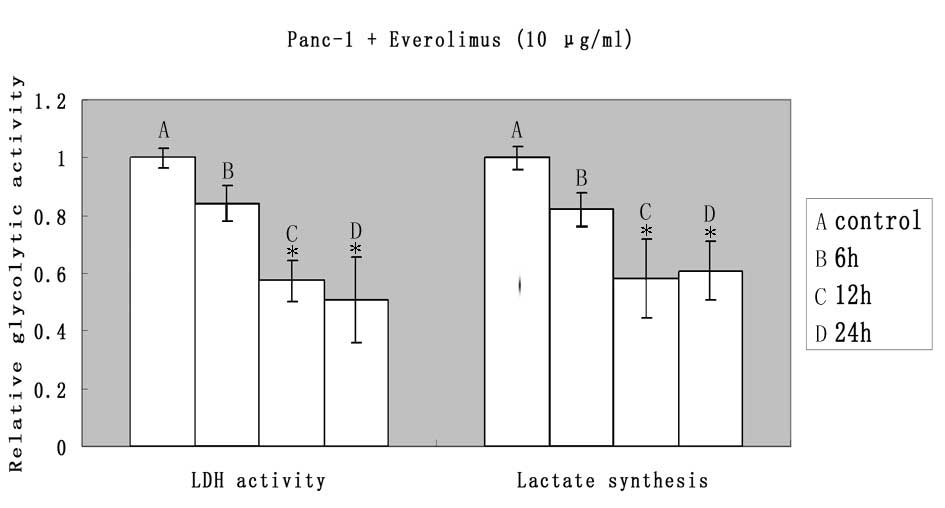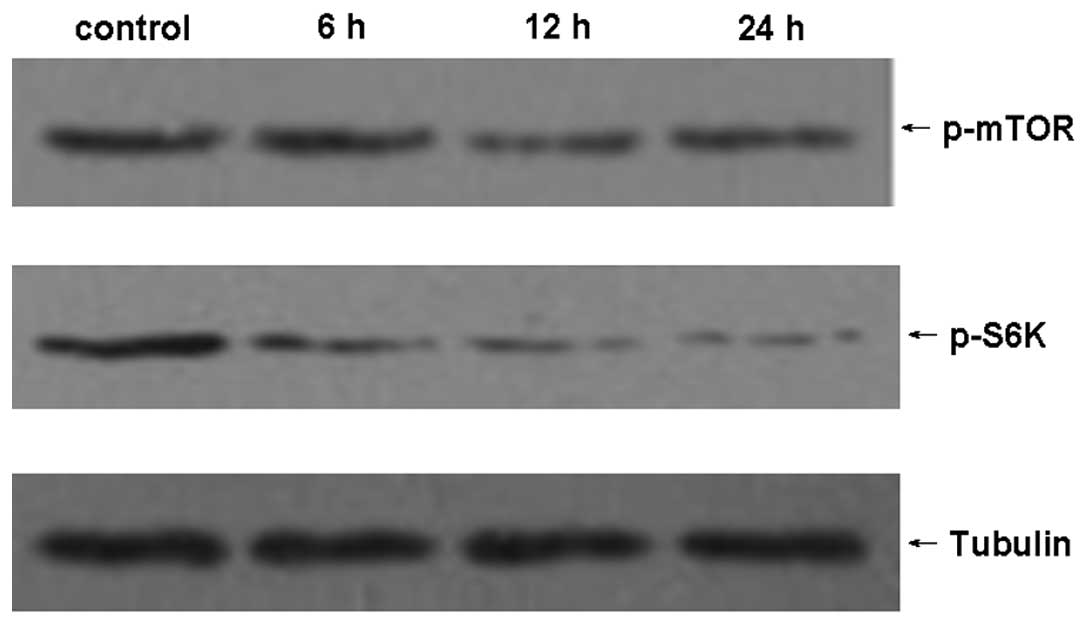|
1
|
Saif MW: Controversies in the adjuvant
treatment of pancreatic adenocarcinoma. JOP. 8:545–552.
2007.PubMed/NCBI
|
|
2
|
Siegel R, Naishadham D and Jemal A: Cancer
statistics, 2012. CA Cancer J Clin. 62:10–29. 2012. View Article : Google Scholar
|
|
3
|
Bayley JP and Devilee P: The Warburg
effect in 2012. Curr Opin Oncol. 24:62–67. 2012. View Article : Google Scholar
|
|
4
|
Dang CV: Links between metabolism and
cancer. Genes Dev. 26:877–890. 2012. View Article : Google Scholar : PubMed/NCBI
|
|
5
|
Ponisovskiy MR: Warburg effect mechanism
as the target for theoretical substantiation of a new potential
cancer treatment. Crit Rev Eukaryot Gene Expr. 21:13–28. 2011.
View Article : Google Scholar : PubMed/NCBI
|
|
6
|
Paez D, Labonte MJ and Lenz HJ: Pancreatic
cancer: medical management (novel chemotherapeutics). Gastroenterol
Clin North Am. 41:189–209. 2012. View Article : Google Scholar : PubMed/NCBI
|
|
7
|
Benjamin D, Colombi M, Moroni C and Hall
MN: Rapamycin passes the torch: a new generation of mTOR
inhibitors. Nat Rev Drug Discov. 10:868–880. 2011. View Article : Google Scholar : PubMed/NCBI
|
|
8
|
Oberstein PE, Remotti H, Saif MW and
Libutti SK: Pancreatic neuroendocrine tumors: entering a new era.
JOP. 13:169–173. 2012.PubMed/NCBI
|
|
9
|
Schwarzlose-Schwarck S, Scholz CW,
Regierer AC, et al: The mTOR inhibitor everolimus in combination
with carboplatin in metastatic breast cancer - a phase I trial.
Anticancer Res. 32:3435–3441. 2012.PubMed/NCBI
|
|
10
|
Pinto-Leite R, Arantes-Rodrigues R,
Palmeira C, et al: Everolimus enhances gemcitabine-induced
cytotoxicity in bladder-cancer cell lines. J Toxicol Environ Health
A. 75:788–799. 2012. View Article : Google Scholar : PubMed/NCBI
|
|
11
|
Tomioka H, Mukohara T, Kataoka Y, et al:
Inhibition of the mTOR/S6K signal is necessary to enhance
fluorouracil-induced apoptosis in gastric cancer cells with HER2
amplification. Int J Oncol. 41:551–558. 2012.PubMed/NCBI
|
|
12
|
Tai S, Sun Y, Liu N, et al: Combination of
Rad001 (everolimus) and propachlor synergistically induces
apoptosis through enhanced autophagy in prostate cancer cells. Mol
Cancer Ther. 11:1320–1331. 2012. View Article : Google Scholar : PubMed/NCBI
|
|
13
|
Matthaios D, Zarogoulidis P, Balgouranidou
I, Chatzaki E and Kakolyris S: Molecular pathogenesis of pancreatic
cancer and clinical perspectives. Oncology. 81:259–272. 2011.
View Article : Google Scholar : PubMed/NCBI
|
|
14
|
Laplante M and Sabatini DM: mTOR signaling
in growth control and disease. Cell. 149:274–293. 2012. View Article : Google Scholar : PubMed/NCBI
|
|
15
|
Magnuson B, Ekim B and Fingar DC:
Regulation and function of ribosomal protein S6 kinase (S6K) within
mTOR signalling networks. Biochem J. 441:1–21. 2012. View Article : Google Scholar : PubMed/NCBI
|
|
16
|
Populo H, Lopes JM and Soares P: The mTOR
signalling pathway in human cancer. Int J Mol Sci. 13:1886–1918.
2012. View Article : Google Scholar : PubMed/NCBI
|
|
17
|
Iwase Y and Maitani Y: Preparation and in
vivo evaluation of liposomal everolimus for lung carcinoma and
thyroid carcinoma. Biol Pharm Bull. 35:975–979. 2012. View Article : Google Scholar : PubMed/NCBI
|
|
18
|
Mathupala SP, Ko YH and Pedersen PL:
Hexokinase II: cancer’s double-edged sword acting as both
facilitator and gatekeeper of malignancy when bound to
mitochondria. Oncogene. 25:4777–4786. 2006.
|
|
19
|
Wolf A, Agnihotri S, Micallef J, et al:
Hexokinase 2 is a key mediator of aerobic glycolysis and promotes
tumor growth in human glioblastoma multiforme. J Exp Med.
208:313–326. 2011. View Article : Google Scholar : PubMed/NCBI
|
|
20
|
Fang R, Xiao T, Fang Z, et al:
MicroRNA-143 (miR-143) regulates cancer glycolysis via targeting
hexokinase 2 gene. J Biol Chem. 287:23227–23235. 2012. View Article : Google Scholar : PubMed/NCBI
|
|
21
|
Akao Y, Nakagawa Y and Naoe T: MicroRNAs
143 and 145 are possible common onco-microRNAs in human cancers.
Oncol Rep. 16:845–850. 2006.PubMed/NCBI
|
|
22
|
Li X, Zhang G, Luo F, et al:
Identification of aberrantly expressed miRNAs in rectal cancer.
Oncol Rep. 28:77–84. 2012.PubMed/NCBI
|
|
23
|
White NM, Youssef YM, Fendler A, Stephan
C, Jung K and Yousef GM: The miRNA-kallikrein axis of interaction:
a new dimension in the pathogenesis of prostate cancer. Biol Chem.
393:379–389. 2012. View Article : Google Scholar : PubMed/NCBI
|
|
24
|
Akao Y, Nakagawa Y, Kitade Y, Kinoshita T
and Naoe T: Downregulation of microRNAs-143 and -145 in B-cell
malignancies. Cancer Sci. 98:1914–1920. 2007. View Article : Google Scholar : PubMed/NCBI
|
|
25
|
Chen HC, Chen GH, Chen YH, et al: MicroRNA
deregulation and pathway alterations in nasopharyngeal carcinoma.
Br J Cancer. 100:1002–1011. 2009. View Article : Google Scholar : PubMed/NCBI
|
|
26
|
Wang X, Tang S, Le SY, et al: Aberrant
expression of oncogenic and tumor-suppressive microRNAs in cervical
cancer is required for cancer cell growth. PLoS One. 3:e25572008.
View Article : Google Scholar : PubMed/NCBI
|
|
27
|
Amaral FC, Torres N, Saggioro F, et al:
MicroRNAs differentially expressed in ACTH-secreting pituitary
tumors. J Clin Endocrinol Metab. 94:320–323. 2009. View Article : Google Scholar : PubMed/NCBI
|
|
28
|
Yu T, Wang XY, Gong RG, et al: The
expression profile of microRNAs in a model of
7,12-dimethyl-benz[a]anthrance-induced oral carcinogenesis in
Syrian hamster. J Exp Clin Cancer Res. 28:642009.PubMed/NCBI
|
|
29
|
Motoyama K, Inoue H, Takatsuno Y, et al:
Over- and under-expressed microRNAs in human colorectal cancer. Int
J Oncol. 34:1069–1075. 2009.PubMed/NCBI
|
|
30
|
Chen X, Guo X, Zhang H, et al: Role of
miR-143 targeting KRAS in colorectal tumorigenesis. Oncogene.
28:1385–1392. 2009. View Article : Google Scholar : PubMed/NCBI
|
|
31
|
Ng EK, Tsang WP, Ng SS, et al:
MicroRNA-143 targets DNA methyltransferases 3A in colorectal
cancer. Br J Cancer. 101:699–706. 2009. View Article : Google Scholar : PubMed/NCBI
|
|
32
|
Borralho PM, Kren BT, Castro RE, da Silva
IB, Steer CJ and Rodrigues CM: MicroRNA-143 reduces viability and
increases sensitivity to 5-fluorouracil in HCT116 human colorectal
cancer cells. FEBS J. 276:6689–6700. 2009. View Article : Google Scholar : PubMed/NCBI
|
|
33
|
Michael MZ, O’Connor SM, van Holst
Pellekaan NG, Young GP and James RJ: Reduced accumulation of
specific microRNAs in colorectal neoplasia. Mol Cancer Res.
1:882–891. 2003.PubMed/NCBI
|
|
34
|
Zhang Y, Wang Z, Chen M, et al:
MicroRNA-143 targets MACC1 to inhibit cell invasion and migration
in colorectal cancer. Mol Cancer. 11:232012. View Article : Google Scholar : PubMed/NCBI
|
|
35
|
Liu L, Yu X, Guo X, et al: miR-143 is
downregulated in cervical cancer and promotes apoptosis and
inhibits tumor formation by targeting Bcl-2. Mol Med Report.
5:753–760. 2012.PubMed/NCBI
|
|
36
|
Jiang S, Zhang LF, Zhang HW, et al: A
novel miR-155/miR-143 cascade controls glycolysis by regulating
hexokinase 2 in breast cancer cells. EMBO J. 31:1985–1998. 2012.
View Article : Google Scholar : PubMed/NCBI
|
|
37
|
Gregersen LH, Jacobsen A, Frankel LB, Wen
J, Krogh A and Lund AH: microRNA-143 down-regulates Hexokinase 2 in
colon cancer cells. BMC Cancer. 12:2322012. View Article : Google Scholar : PubMed/NCBI
|














